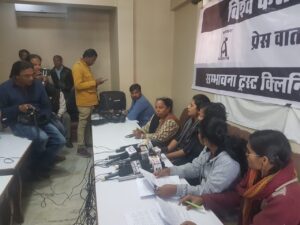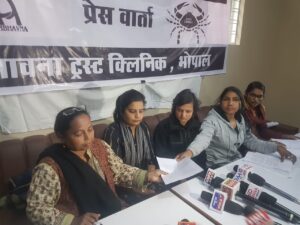 At a Press Conference on World Cancer Day, February 3rd 2020, members of the Sambhavna Trust Clinic presented data on the alarming prevalence of cancer among the survivors of the Union Carbide gas disaster in Bhopal. The members expressed concern at the lack of facilities for the treatment of gas affected cancer patients and called for the setting up of proper registration of cancers for the gas affected people in the city.
At a Press Conference on World Cancer Day, February 3rd 2020, members of the Sambhavna Trust Clinic presented data on the alarming prevalence of cancer among the survivors of the Union Carbide gas disaster in Bhopal. The members expressed concern at the lack of facilities for the treatment of gas affected cancer patients and called for the setting up of proper registration of cancers for the gas affected people in the city.
Established in 1996 to provide free medical care to the victims of Union Carbide, the Sambhavna Trust Clinic has treated 25,270 people with acute exposure to Methyl Isocyanate and other toxic gases, and 7,383 people with chronic exposure to groundwater contaminated by Union Carbide’s poisonous wastes. While the Sambhavna clinic does not currently have the facilities for the treatment of cancers, the centre has staff with the expertise to diagnose patients with cancers and refer them for treatment to other facilities in Bhopal.
Directly following the disaster, the Indian Council of Medical Research (ICMR) undertook twenty-two studies into the effects of exposure to the gases on survivors, including rates of cancers and other illnesses, as well as setting up the Population Based Cancer Registry in Bhopal in 1985. However, the studies were abruptly halted in 1994, and it was subsequently discovered that they had lost the records of 8 in 10 of the original cohort of 80,021 survivors. Following this discovery, a team of 25 researchers at Sambhavna began their own study in 2009 into the rates of both cancers and birth defects among the exposed population. Working door-to-door across dozens of affected communities, the team gathered data on deaths, cancers, birth defects and other ailments across the affected communities. In total they were able to register a cohort population of 94,000 people, equivalent in scale to the original ICMR project. The study includes groups exposed to gas, contaminated groundwater, and a control group of people of similar socio-economic status in the city.
 “Our data shows that the prevalence of cancers among the people exposed to Union Carbide’s gases is eight times more than that of an unexposed population in Bhopal. Compared to an unexposed population, the prevalence of cancer is almost double in the population that has had exposure to groundwater contaminated by Union Carbide’s hazardous wastes. All of these findings are of diagnosed cancers and we have copies of the relevant medical records of each case” said Farhat Jahan, community research worker at the clinic in a Press Statement Monday.
“Our data shows that the prevalence of cancers among the people exposed to Union Carbide’s gases is eight times more than that of an unexposed population in Bhopal. Compared to an unexposed population, the prevalence of cancer is almost double in the population that has had exposure to groundwater contaminated by Union Carbide’s hazardous wastes. All of these findings are of diagnosed cancers and we have copies of the relevant medical records of each case” said Farhat Jahan, community research worker at the clinic in a Press Statement Monday.
Prevalence of Cancer in Bhopal Based Populations with Different Histories of Toxic Exposure (2010 – 2011):
| Exposure History | Population
|
Individuals Diagnosed with Cancer | Diagnosed Cancer per Thousand | No. of Times Compared to Unexposed Population |
| Toxic Gas | 28437 | 253 | 8.89 | 8.3 |
| Contaminated Groundwater | 23691 | 41 | 1.73 | 1.61 |
| No toxic exposure | 22380 | 24 | 1.07 |
Ten years on, the figures gathered from nearly 75,000 people in Bhopal in the first years of the study show extremely alarming results. Rates of cancers are a staggering eight times higher among the gas exposed population, while rates among those exposed to toxic water contamination are more than one-and-a-half times higher. Additionally, the population of those exposed to toxic groundwater has risen considerably since the study began, as the chemicals continue to seep into ground from the site. In 2010 the exposed population was estimated at roughly 25,000 people, while today it is closer to 100,000. In addition to the raw numbers of those affected, the study also includes data on the types of cancer most commonly found among the affected population.
“Throat, lungs, oral, stomach, and breast cancers are most common among the gas exposed people. We found that in the areas that were severely affected by the poisonous gases, twice as many people were dying of cancers compared to an unexposed population. Official data shows that till October last year, 8,551 gas victims with cancers have been paid ex-gratia amounts by the government” explained Mahendra Soni, Technician in charge of the Pathology Laboratory at Sambhavna.
The provisional findings from the study that Mahendra refers to here, although based upon a smaller data sample, have already shown that there are 28% more deaths among the exposed population than the control population, with twice as many people dying of cancers among the exposed population. Complete data from Sambhavna on varieties and rates of cancers among unexposed and exposed populations can be found in the table below:
Individuals Diagnosed with Different Types of Cancer in Different Populations of Bhopal (2010 – 2011):
| No. | Type of Cancer | Unexposed | Percentage | Exposed to Toxic gas | Percentage | Exposed to Contaminated Groundwater | Percentage |
| 1 | Blood | 1 | 4.17 | 12 | 4.74 | 6 | 14.63 |
| 2 | Lungs | 1 | 4.17 | 19 | 7.51 | 3 | 7.31 |
| 3 | Liver | 0 | 9 | 3.55 | 0 | ||
| 4 | Rectal | 0 | 1 | 0.39 | 0 | ||
| 5 | Stomach | 4 | 16.67 | 31 | 12.25 | 2 | 4.87 |
| 6 | Ovary | 7 | 29.17 | 19 | 7.51 | 5 | 12.19 |
| 7 | Throat | 3 | 12.5 | 59 | 23.32 | 12 | 29.26 |
| 8 | Prostate | 0 | 3 | 1.19 | 0 | ||
| 9 | Breast | 3 | 12.5 | 32 | 12.65 | 2 | 4.87 |
| 10 | Oral | 2 | 8.33 | 34 | 13.44 | 1 | 2.43 |
| 11 | Other | 3 | 12.5 | 34 | 13.44 | 10 | 24.39 |
| TOTAL | 24 | 100 | 253 | 100 | 41 | 100 | |
Perhaps unsurprisingly, given the nature of the original gas Methyl Isocyanate, rates of throat cancer in particular are far higher among those exposed to both gas and groundwater than among the unexposed population. Rates of oral and lung cancers are also higher among the gas exposed population, while rates of blood cancer are more than three times higher among those affected by toxic groundwater than among the unexposed population.
As the representatives of the Sambhavna Trust at the Press Conference made clear, these figures are even more worrying in light of the fact that there are currently no facilities for treatment of cancers available at any of the state or central run government hospitals for gas survivors in the city, as reported in The Times of India last month.
“While the number of gas victims with cancers is growing at an alarming rate, there are no facilities for treatment of cancer in the hospitals run for the gas victims by the state and central governments. The private and trust run cancer hospitals that gas victims are asked to go to have not been paid for at least one year by the government and this is impacting the quality of care in a serious way. No action has been taken regarding provision of palliative care to gas affected cancer patients as recommended by the Monitoring Committee more than two years back” said Aziza Sultan, gynaecology assistant at the clinic.
The primary hospital for gas survivors in the city is the Bhopal Memorial Hospital & Research Centre, which was setup by order of the Supreme Court in 2001 specifically for treatment of those affected by the gas. However, BMHRC’s oncology department closed back in 2017 and the hospital is currently in crisis after 14 of its 15 doctors staged a mass walkout last month. Due to the lack of facilities for cancer treatment at BMHRC and the other state and government run hospitals for gas survivors, patients are referred to private and trust run hospitals where they are often forced to pay upfront for treatment. Although the cost should theoretically be repaid at a later date by the government, the lack of funding to these facilities over the past year means those few who can afford to pay may have trouble reclaiming their money, while a vast majority simply cannot afford the initial cost of treatment. As a result thousands are left without care that they desperately need.
Deepa Mandrai, Community Health Worker for the Sambhavna Trust, accused the registry of cancer patients in the city of neglecting those patients affected by the gases. “There appears to be deliberate neglect in registering gas affected cancer patients by the Population Based Cancer Registry in Bhopal established by the Indian Council of Medical Research (ICMR) in 1985. While the registry was specially established to record the effect of gas exposure on cancer prevalence, the registry does not collect information on the history of exposure to Union Carbide’s gases of cancer patients” she said in a statement.
This would not be the first time survivors have questioned the findings of the ICMR. Back in 2010 the ICMR published its own study on cancer rates among the MIC exposed population from 1988-2007. The report claimed that the higher incidences of mouth, throat and lung cancers among the exposed population were due not to gas exposure, but to higher rates of smoking compared with the unexposed population. Following the publication of the report survivor groups called the results of the study into question, arguing that far fewer of those among the exposed population had participated in the study than claimed by the ICMR and questioning both the scope and accuracy of the reported data.
Critically, The Hindu reported this week that, following the mass staff walkout, the Bhopal Memorial Hospital and Research Centre is due to come back under management by the ICMR. In light of the findings of the research of the Sambhavna Trust, it is essential that the ICMR begin an honest process of adding survivors to the Population Based Cancer Registry of Bhopal, as well as keeping a thorough record of cancer rates among those exposed to the gas and toxic groundwater. Additionally, the ICMR and Central Government must fulfil their obligation to the survivors by resuming funding to the private and trust hospitals in the city immediately, while also re-opening the oncology department at BMHRC and establishing facilities for the treatment of cancers at the other state and government run hospitals in the city.
Our thanks to Mahendra Soni, Aziza Sultan, Farhat Jahan, Deepa Mandrai, Bhagwan S Patel, and Nargis Naaz of the Sambhavna Trust for holding the Press Conference and sharing the results of the study on World Cancer Day 2020.


